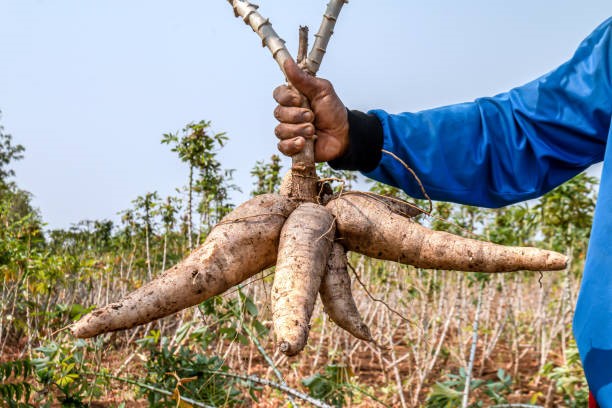Cassava is, after maize, the second most important food security crop grown by more than 40% of the African population. Drought and increases in temperature are the major stress factors that pose a serious threat to world food security, especially in the changing climate scenario.
Cassava’s Role in Climate-Smart Agriculture
South Africa is one of the countries affected by climate change and has experienced severe drought and floods in recent years. The ability of cassava to withstand difficult growing conditions such as extreme drought, heat, and soil acidity makes it a suitable crop for climate-smart agriculture.
Cassava is also listed as the fourth most important source of starch, after maize, wheat and potato worldwide. Cassava supplied more than 8 million tons of industrial starch to the global market and the global demand for cassava starch is projected to be over 10 million tons by 2024. Hence, designing sustainable agro-ecology based solutions and grasping the industrial potential of cassava will improve the livelihoods of small-scale farmers and facilitate the adoption of climate smart agriculture.

Healthy Cassava roots
The Key Component in Food Security Strategies
The ARC and its partners have identified cassava as a food security crop and as an alternative source of starch for the starch industry to replace imports. Cassava has also been endorsed as one of the climate risk mitigation strategies for managing food price inflation resulting from competing user interests in major staple food crops such as maize, wheat, and potato. Knowledge on propagation and cultivation practices is critical to integrate cassava into the current production systems in South Africa.
Cassava requires a seed dormancy stage of 3-6 months to ripen before planting and the seeds should be stored at ambient temperature. The seeds should be planted in a greenhouse for germination and the seedlings should be transplanted to the field when they are about 20-25 cm tall. Cassava propagation through botanical seed is constrained by low and uneven germination. This may be attributed either to environmental factors such as light and temperature or to the inherent seed dormancy, or a combination of the two.
Enhancing Seed Germination
However, seed germination can be hastened either by mechanical scarification of the seed coat, or exposing the seeds to a dry heat treatment at 60ºC for 14 days or to a cold treatment at 4ºC for 24 hours. Light negatively affects both seed germination and the speed of germination. Plants derived from seed produce fewer and smaller tubers than those from stem cuttings.
Best Practices for Stem Cuttings
Cassava can be propagated by stem cuttings derived from a mature plant. Stem cuttings (stakes) obtained from the middle part of the stem have better sprouting and good plant establishment than those derived from the lower and upper part of the stem. The stems can be stored for 2 – 5 days in the shade after they have been harvested and the distal ends should be covered with moist soil.
Stems should not be stored for more than two weeks to obtain at least 80% sprouting. The stems should be treated with maximum care as not to damage the nodes that may result in the loss of the stakes. Depending on the plant height, from one plant, 5-10 stakes of 25 cm in length with 5-7 nodes can be obtained. Mature stems should be carefully cut with sharp tools to avoid damage, the stakes should not be splintered, and the bark should not be chipped off.
To prevent the spread of pests and diseases, the stakes should be treated with agrochemicals. The implements used to cut the stem should also be cleaned with chemicals before and after use.
Innovative Propagation Techniques
The International Institute of Tropical Agriculture (IITA), Ibadan, Nigeria has developed a rapid multiplication technology using mini stem cuttings varying in length depending on the stem portion from which the cuttings are taken. A 5 cm stake with 1 – 2 nodes from the hardwood portion, a 10 cm stake with 4 – 6 nodes from the semi-mature portion, and a 20 cm stake with 6 – 10 nodes from the tip portion of the stem should be used.

Cassava stem cuttings are perishable, bulky, that requires considerable storage space and is difficult to transport. Well-rooted cassava plantlets of 4-5 cm in length were found to be successful for hardening off and had the maximum success rate (91%) for establishment in sterilized vermiculite.
Establishment of propagation nurseries is crucial to ensure a sustainable supply of disease-free cassava stakes. These nurseries can be established either at research stations or on farmer fields that are isolated from other cassava fields at a distance of about 150 – 200m to reduce the chance of insects carrying plant diseases into the nurseries. The nurseries should be easily accessible to farmers for sourcing planting materials and for training purposes.
On a hectare of land at a spacing of 50 cm x 50 cm, it is possible to produce about 40 000 plants. If 10 stakes are obtained from one plant on average, 400 000 stakes can be harvested and that will be sufficient to plant 40 hectares of land. The ARC aims to develop a nursery system for cassava to support the expanding commercial cassava industry in South Africa because of the important substitution for starch will support local entrepreneurship and income generation. By: Dr Amelework Assefa at ARC-VIMP
